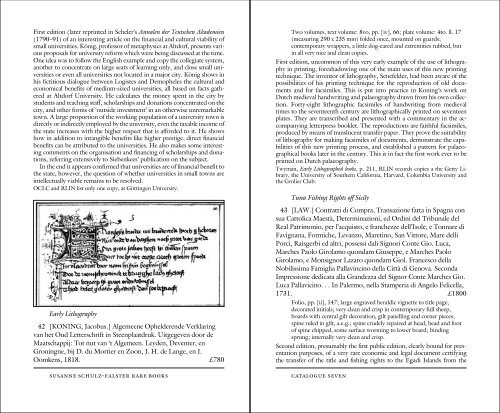Catalogue Number 7 - Susanne Schulz-Falster
Catalogue Number 7 - Susanne Schulz-Falster
Catalogue Number 7 - Susanne Schulz-Falster
You also want an ePaper? Increase the reach of your titles
YUMPU automatically turns print PDFs into web optimized ePapers that Google loves.
First edition (later reprinted in Scheler’s Annalen der Teutschen Akademien<br />
(1790–91) of an interesting article on the Wnancial and cultural viability of<br />
small universities. König, professor of metaphysics at Altdorf, presents various<br />
proposals for university reform which were being discussed at the time.<br />
One idea was to follow the English example and copy the collegiate system,<br />
another to concentrate on large seats of learning only, and close small universities<br />
or even all universities not located in a major city. König shows in<br />
his Wctitious dialogue between Logistes and Demopheles the cultural and<br />
economical beneWts of medium-sized universities, all based on facts gathered<br />
at Altdorf University. He calculates the money spent in the city by<br />
students and teaching staV, scholarships and donations concentrated on the<br />
city, and other forms of ‘outside investment’ in an otherwise unremarkable<br />
town. A large proportion of the working population of a university town is<br />
directly or indirectly employed by the university, even the taxable income of<br />
the state increases with the higher respect that is aVorded to it. He shows<br />
how in addition to intangible beneWts like higher prestige, direct Wnancial<br />
beneWts can be attributed to the universities. He also makes some interesting<br />
comments on the organisation and Wnancing of scholarships and donations,<br />
referring extensively to Siebenkees’ publication on the subject.<br />
In the end it appears conWrmed that universities are of Wnancial beneWt to<br />
the state, however, the question of whether universities in small towns are<br />
intellectually viable remains to be resolved.<br />
OCLC and RLIN list only one copy, at Göttingen University.<br />
Early Lithography<br />
42 [KONING, Jacobus.] Algemeene Ophelderende Verklaring<br />
van het Oud Letterschrift in Steenplaatdruk. Uitgegeven door de<br />
Maatschappij: Tot nut van ‘t Algemeen. Leyden, Deventer, en<br />
Groningne, bij D. du Mortier en Zoon, J. H. de Lange, en J.<br />
Oomkens, 1818. £780<br />
susanne schulz-falster rare books catalogue seven<br />
Two volumes, text volume: 8vo, pp. [iv], 66; plate volume: 4to. ll. 17<br />
(measuring 290 x 235 mm) folded once, mounted on guards;<br />
contemporary wrappers, a little dog-eared and extremities rubbed, but<br />
in all very nice and clean copies.<br />
First edition, uncommon of this very early example of the use of lithography<br />
in printing, foreshadowing one of the main uses of this new printing<br />
technique. The inventor of lithography, Senefelder, had been aware of the<br />
possibilities of his printing technique for the reproduction of old documents<br />
and for facsimiles. This is put into practice in Koning’s work on<br />
Dutch medieval handwriting and palaeography drawn from his own collection.<br />
Forty-eight lithographic facsimiles of handwriting from medieval<br />
times to the seventeenth century are lithographically printed on seventeen<br />
plates. They are transcribed and presented with a commentary in the accompanying<br />
letterpress booklet. The reproductions are faithful facsimiles,<br />
produced by means of translucent transfer paper. They prove the suitability<br />
of lithography for making facsimiles of documents, demonstrate the capabilities<br />
of this new printing process, and established a pattern for palaeographical<br />
books later in the century. This is in fact the Wrst work ever to be<br />
printed on Dutch palaeography.<br />
Twyman, Early Lithographed books, p. 211, RLIN records copies a the Getty Library,<br />
the University of Southern California, Harvard, Columbia University and<br />
the Grolier Club.<br />
Tuna Fishing Rights oV Sicily<br />
43 [LAW.] Contratti di Compra, Transazione fatta in Spagna con<br />
sua Cattolica Maestà, Determinazioni, ed Ordini del Tribunale del<br />
Real Patrimonio, per l’acquisto, e franchezze dell’Isole, e Tonnare di<br />
Favignana, Formiche, Levanzo, Maretino, San Vittore, Mare delli<br />
Porci, Raisgerbi ed altri, possessi dali Signori Conte Gio. Luca,<br />
Marches Paolo Girolamo quondam Giuseppe, e Marches Paolo<br />
Girolamo, e Monsignor Lazaro quondam Giol. Francesco della<br />
Nobilissima Famiglia Pallavincino della Città di Genova. Seconda<br />
Impressione dedicata alla Grandezza del Signor Conte Marches Gio.<br />
Luca Pallavicino. . . In Palermo, nella Stamperia di Angelo Felicella,<br />
1731. £1800<br />
Folio, pp. [ii], 147; large engraved heraldic vignette to title page,<br />
decorated initials; very clean and crisp in contemporary full sheep,<br />
boards with central gilt decoration, gilt panelling and corner pieces;<br />
spine ruled in gilt, a.e.g.; spine crudely repaired at head, head and foot<br />
of spine chipped, some surface worming to lower board; binding<br />
sprung; internally very clean and crisp.<br />
Second edition, presumably the Wrst public edition, clearly bound for presentation<br />
purposes, of a very rare economic and legal document certifying<br />
the transfer of the title and Wshing rights to the Egadi Islands from the

















